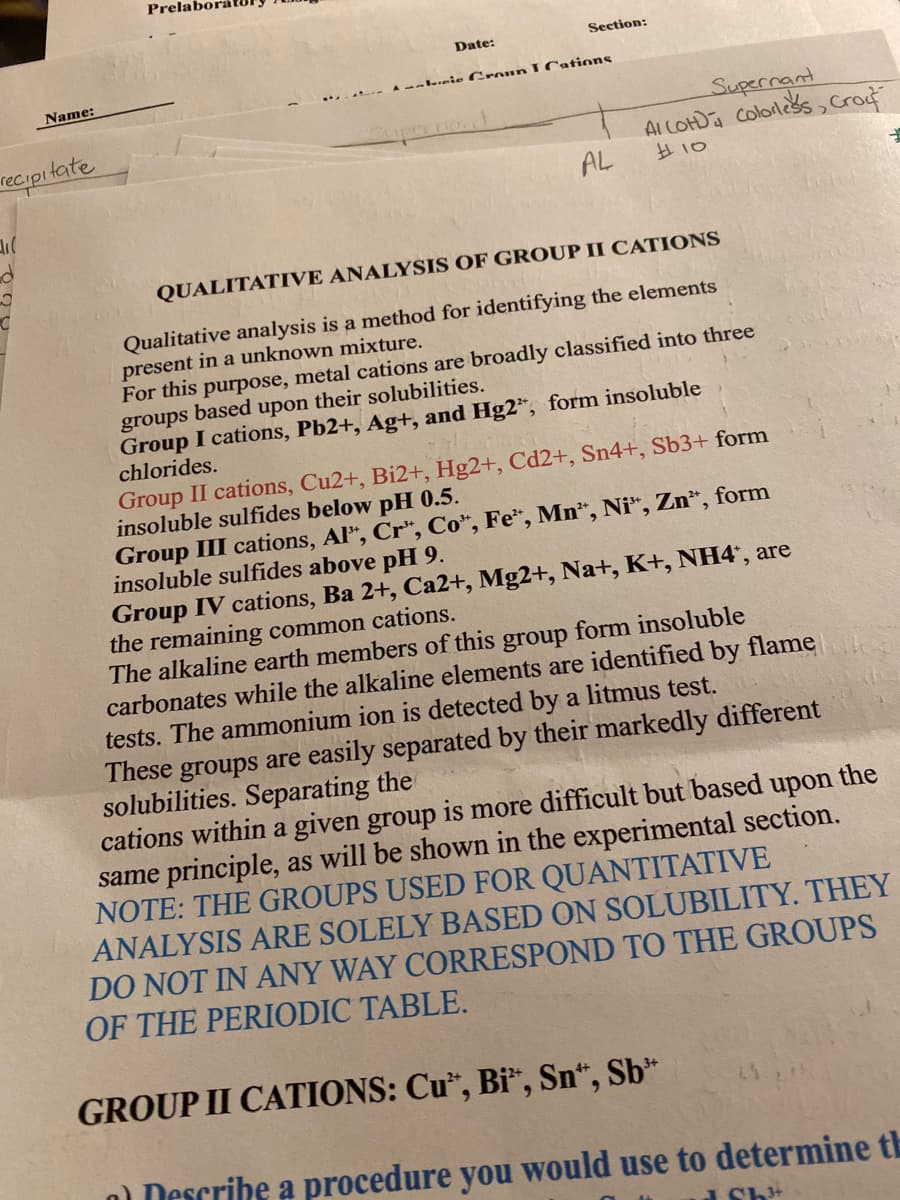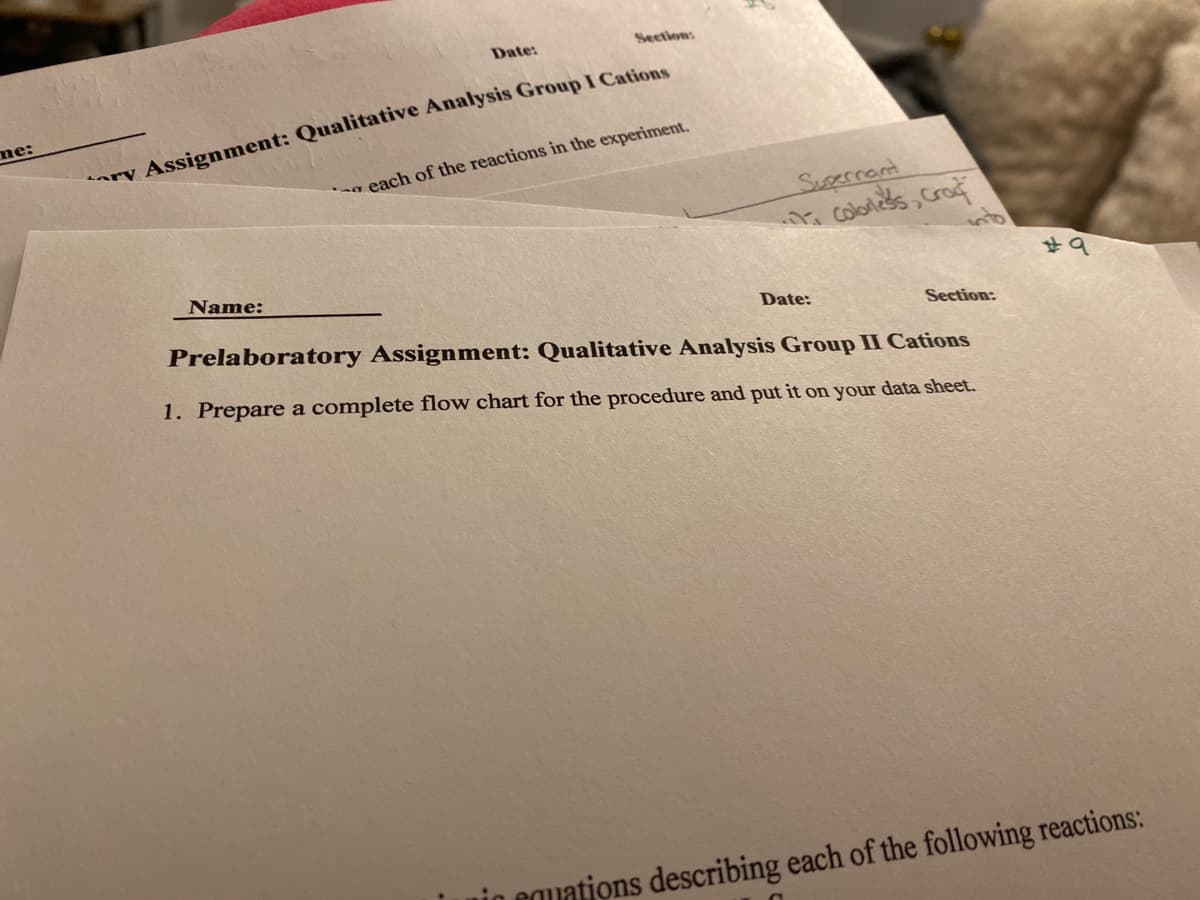Name: Prelaboratory Assignment: Qualitative Analysis Group II Cations 1. Prepare a complete flow chart for the procedure and put it on your data sheet.
Name: Prelaboratory Assignment: Qualitative Analysis Group II Cations 1. Prepare a complete flow chart for the procedure and put it on your data sheet.
Chemistry: Principles and Practice
3rd Edition
ISBN:9780534420123
Author:Daniel L. Reger, Scott R. Goode, David W. Ball, Edward Mercer
Publisher:Daniel L. Reger, Scott R. Goode, David W. Ball, Edward Mercer
Chapter14: Chemical Equilibrium
Section: Chapter Questions
Problem 14.97QE: According to the Resource Conservation and Recovery Act (RCRA), waste material is classified as...
Related questions
Question

Transcribed Image Text:Prelaboral
Date:
sie Croun I Cations
Supernant
AI COH) Colorless, Croc
AL
#10
QUALITATIVE ANALYSIS OF GROUP II CATIONS
Qualitative analysis is a method for identifying the elements
present in a unknown mixture.
For this purpose, metal cations are broadly classified into three
groups based upon their solubilities.
Group I cations, Pb2+, Ag+, and Hg2", form insoluble
chlorides.
Group II cations, Cu2+, Bi2+, Hg2+, Cd2+, Sn4+, Sb3+ form
insoluble sulfides below pH 0.5.
Group III cations, Al", Cr", Co", Fe, Mn, Ni", Zn, form
insoluble sulfides above pH 9.
Group IV cations, Ba 2+, Ca2+, Mg2+, Na+, K+, NH4*, are
the remaining common cations.
The alkaline earth members of this group form insoluble
carbonates while the alkaline elements are identified by flame
tests. The ammonium ion is detected by a litmus test.
These groups are easily separated by their markedly different
solubilities. Separating the
the
cations within a given group is more difficult but based upon
same principle, as will be shown in the experimental section.
NOTE: THE GROUPS USED FOR QUANTITATIVE
ANALYSIS ARE SOLELY BASED ON SOLUBILITY. THEY
DO NOT IN ANY WAY CORRESPOND TO THE GROUPS
OF THE PERIODIC TABLE.
GROUP II CATIONS: Cu, Bi, Sn, Sb³
Describe a procedure you would use to determine th
J Sh³+
Name:
recipitate
Section:
5

Transcribed Image Text:me:
Date:
Section:
ary Assignment: Qualitative Analysis Group I Cations
each of the reactions in the experiment.
Supernant
Colorles's, Craf
Name:
Date:
Section:
Prelaboratory Assignment: Qualitative Analysis Group II Cations
1. Prepare a complete flow chart for the procedure and put it on your data sheet.
#9
Cuations describing each of the following reactions:
Expert Solution
This question has been solved!
Explore an expertly crafted, step-by-step solution for a thorough understanding of key concepts.
This is a popular solution!
Trending now
This is a popular solution!
Step by step
Solved in 2 steps with 2 images

Knowledge Booster
Learn more about
Need a deep-dive on the concept behind this application? Look no further. Learn more about this topic, chemistry and related others by exploring similar questions and additional content below.Recommended textbooks for you

Chemistry: Principles and Practice
Chemistry
ISBN:
9780534420123
Author:
Daniel L. Reger, Scott R. Goode, David W. Ball, Edward Mercer
Publisher:
Cengage Learning

EBK A SMALL SCALE APPROACH TO ORGANIC L
Chemistry
ISBN:
9781305446021
Author:
Lampman
Publisher:
CENGAGE LEARNING - CONSIGNMENT

Chemistry & Chemical Reactivity
Chemistry
ISBN:
9781337399074
Author:
John C. Kotz, Paul M. Treichel, John Townsend, David Treichel
Publisher:
Cengage Learning

Chemistry: Principles and Practice
Chemistry
ISBN:
9780534420123
Author:
Daniel L. Reger, Scott R. Goode, David W. Ball, Edward Mercer
Publisher:
Cengage Learning

EBK A SMALL SCALE APPROACH TO ORGANIC L
Chemistry
ISBN:
9781305446021
Author:
Lampman
Publisher:
CENGAGE LEARNING - CONSIGNMENT

Chemistry & Chemical Reactivity
Chemistry
ISBN:
9781337399074
Author:
John C. Kotz, Paul M. Treichel, John Townsend, David Treichel
Publisher:
Cengage Learning

General, Organic, and Biological Chemistry
Chemistry
ISBN:
9781285853918
Author:
H. Stephen Stoker
Publisher:
Cengage Learning

Introduction to General, Organic and Biochemistry
Chemistry
ISBN:
9781285869759
Author:
Frederick A. Bettelheim, William H. Brown, Mary K. Campbell, Shawn O. Farrell, Omar Torres
Publisher:
Cengage Learning

Chemistry
Chemistry
ISBN:
9781305957404
Author:
Steven S. Zumdahl, Susan A. Zumdahl, Donald J. DeCoste
Publisher:
Cengage Learning